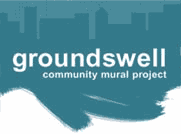

[2001-1996 Projects]
* Sunset Park Unity Mural
* Groundswell Summer...
* Scene Through a Fence
* Peace is Not A Dream...
* We are Here to...
* Paradise Lost and...
* Everyone Holds a World...
* How Our People Left...
Peace is not a dream in storage

PEACE IS NOT A DREAM IN STORAGE
Groundswell Community Mural Project ©
www.groundswellmural.org
Acrylic on Brick
16 x 85 Ft
1999
Lead Artist: Amy Sananman
Youth Artists: Margareta Casanove, Karen Coto, Menshahat Ebron, Julia Friend, Shari Peters, Griseth Segarra, Lelahni Williams, Evita Pagan, Jennifer Thompson.
Location: Park Slope, Brooklyn.
Community Partner: Teen Women's Program of the Center for Anti-Violence Education
The Project
In spring 1999, Groundswell partnered with the Center for Anti Violence Education (CAE), to bring together a diverse group of nine young women to create a mural around the theme of anti-violence against women. The project created an opportunity to learn on a number of fronts. Among these were included how to: express an idea visually; accept, tolerate and collaborate with people whose ideas differ from your own; take pride in oneself and others; understand the importance of patience and listening to others; understand the complexity of public art and its interpretation. In addition, project "glitches" became opportunities to learn.
Search for Site Becomes Opportunity to Learn
The original concept was to paint the mural on the outside of a subway station near CAE-the site of several attacks against women over the past year. Despite support from many community groups and elected officials including: The Fifth Avenue Committee (FAC), Care About the Slope (CATS), Community Board 6, Councilman Rodriguez, Congressman Ed Townes and Brooklyn Borough President Howard Golden, the MTA was unwilling to give the group the special permission necessary to do the project. The group turned this initial refusal into an opportunity to learn about community activism and organizing and coordinated two workshops with the Fifth Avenue Committee on strategies for local activism. They considered their options, created a petition and agreed to secure a back up wall for which they would design the mural.
Symbolism of Mural
Based on discussion of their own experiences and current events along with art making and poetry workshops, the group developed a design. The wall is divided into four parts, focusing on four main themes: Causes of Violence; Empathy as a Way to Decrease Violence; Our Responsibility to Hold Perpetrators Responsible and Show Solidarity with Others, and; A Vision of Anti Violence/ Peace.
On the left, three young women hold a banner. They symbolize the group of young artists themselves and, like all the figures in the mural, are painted blue to transcend the representation of any particular race. Beside them is a maze, both it and its contents representing the causes of violence. The maze symbolizes desperation or confusion, a state of mind that many of the group felt led to acts of violence. In the maze we also see a hand holding the world, conveying here that idea that greed leads to violence. A marionette illustrates that at times people are easily controlled or can be lead into violent behavior by others. The group also felt that sometimes the circumstances in how we are raised, or something in our past, can lead to violent behavior. This point is conveyed with an image of a "Skeleton in a Closet." Finally, symbolized by a pack of dogs, the group felt that peer pressure can lead to violent behavior.
The second focus of the mural suggests that empathy is a way to decrease violence. The group felt that by putting oneself in another's situation (walking a mile in someone else's shoes) violence would decrease. Imagine, the teens ask in the mural, if men could get pregnant.
They felt that a critical aspect in working toward anti-violence is the responsibility to speak out and in so doing, hold perpetrators responsible and show solidarity with others who have experienced violence. This is illustrated by the central woman's voice, depicted as a hurricane surrounding the shadow of the perpetrator. Here a woman is also sweeping away the symbols of violence (knives, needles, etc.).
Following the narrative of the mural, the last section presents the community with a dream of anti-violence. Here a young woman is safely sleeping and dreaming of peace. Above her head is a poem written collaborative by the group, their dream. The poem's last line emphasizes the group’s final message:
‘Peace is not something we keep on a shelf, it is something we use and something we each create in our day-to-day decisions and actions. Don't you see that some of our children are lost, Wandering through a maze, searching for values to lead them. A simple act of awakening: what you feel, I feel. You have the power. To sweep away the bad and shout out the good. Peace is not a dream in storage, make it the next thing you do’.
This project was made possible in part by our funders. For Groundswell Community Mural Project: Puffin Foundation, Park Slope Civic Council, Independence Community Foundation, Lily Auchincloss Foundation, and the Decentralized Program, a re-grant program of the NYS Council on the Arts, administered by the Brooklyn Arts Council. For the Center for Anti-Violence Education: Ms. Foundation's Collaborative for Healthy Girls/ Healthy Women, Liz Claiborne Foundation, and NYS Department of Health.
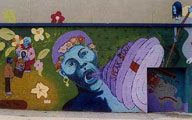 |
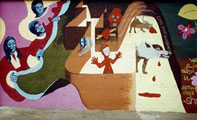 |
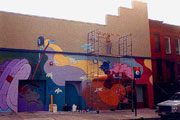 |
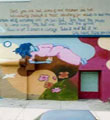 |
